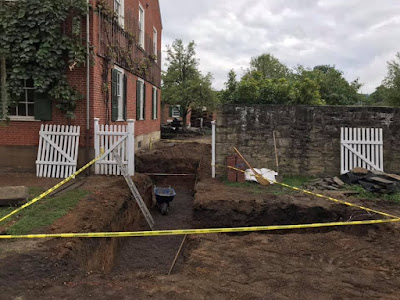Be sure to check out the September program page for upcoming online programs. The Trailheads Rec Room (to the right of your screen) has samples of online offerings available anytime day or night.
Well, campers, this week got away from me, so today's post is even more random than usual. I hear some of you asking, "How is that possible?" Trust me, I have not yet reached my limits on randomness. Buckle up! Oh, and please celebrate responsibly on Labor Day. I know you will.
In honor of National Wildlife Day, here's a nature photo taken at Daniel Boone Homestead (they regularly post on #WildlifeWednesdays). According to the info posted, this "imperial moth of the family Saturniidae is one of our largest and most spectacular moths with a wingspan reaching up to seven inches. As with most moths the adult imperial moth is largely nocturnal but can be spied resting on trees, rocks or vegetation during the daytime. This example was spotted in a grassy area near the North Picinic Area." Although the historic buildings and visitor center at the site are closed, outdoor areas at Daniel Boone Homestead (and other sites on the Trails of History) are open for visitors during posted hours.
 |
Trenches alongside the Frederick Rapp House at Old Economy Village for the installation of pipelines as part of a large preservation project (photo via Facebook)
|
Major building and collections preservation projects continue on the Trails of History. At Old Economy Village (see above) the work includes pipeline installation at the Frederick Rapp House and a new roof on the Feast Hall (visit
Old Economy's Facebook page for additional photos of the ongoing work. At Cornwall Iron Furnace (see below) a stationary steam engine is undergoing needed restoration work. According to
Cornwall's Facebook page, the work includes "cleaning the engine, fabrication and installation of missing oil cups, and repairs to the masonry and wooden base." The engine dates from the late 1850s but has had some modifications over the years. (You can hear site administrator Mike Emery talk about preservation and Cornwall history on a
recent edition of the Practical Preservation Podcast.)
 |
| Exhibit of artifacts related to the U.S. Army Signal Corps' use of pigeons to carry messages (photo via Facebook) |
The staff at the Pennsylvania Military Museum have been using Facebook and their blog to share all kinds of interesting artifacts and stories from the collection. With a new season upon us, they're looking for input on what their readers might be interested in. They've posted on Facebook with
room in the comments to suggest ideas or ask questions.







0 comments:
Post a Comment